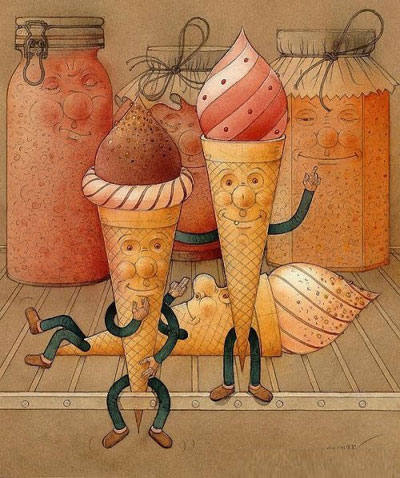|
THE EMPEROR OF ICE-CREAM
Wallace Stevens

Call the roller of big cigars,
The muscular one, and bid him whip
In kitchen cups concupiscent curds.
Let the wenches dawdle in such dress
As they are used to wear, and let the boys
Bring flowers in last month's newspapers.
Let be be finale of seem.
The only emperor is the emperor of ice-cream
Take from the dresser of deal,
Lacking the three glass knobs, that sheet
On which she embroidered fantails once
And spread it so as to cover her face.
If her horny feet protrude, they come
To show how cold she is, and dumb.
Let the lamp affix its beam.
The only emperor is the emperor of ice-cream.
All poems have a You and an I—although they don’t always use those
pronouns explicitly. In the simplest instances the “I” is the creative
presence we call The Poet—a wise, perceptive, linguistically brilliant
speaker such as Keats in his Odes or Shakespeare in his sonnets. Whatever
the subject, the Poet’s “I” speaks to his or her receptive reader’s “You.”
Poetry is the most intimate of the verbal arts and it is largely the You & I
dynamic that makes it so. When it is working it provides the energy source
that generates what we might call the current or electricity of the poem.
Wallace Stevens says that the poet’s goal is “to confer his identity upon the
reader.” Whether the poet speaks to us directly or silently through
intermediary voices called personas if we feel entertained and enlightened
the spiritual fusion between poet and reader will take place.
In “The Emperor of Ice Cream” Stevens confers his identity upon readers
by asking us to collaborate with him on creating the poem. More like GPS
or Siri than your usual bard, he pretends that his role is simply to give
directions.
You, reader, are asked to drive almost everything that occurs in the first
stanza. You call the roller of big cigars; you bid him whip concupiscent
curds in kitchen cups; you let wenches dawdle in warm weather dresses;
you allow boys to bring them flowers wrapped in old newspapers. You
initiate, actualize, allow, or confirm everything that happens in stanza one.
All the poet does is reiterate his title in the last line, implying that your
actions prove it to be a true statement.
The imaginative ice-cream you create is a symbol for the creative impulse
that Henri Bergson called élan vital—an impulse that issues from what jazz
artist Clifford Brown later called the “Joy Spring” of the human spirit. You
have succumbed to the imperial power of that season of life where robust
health, blissful sexuality, and pure delight in being are so strong that what’s
on its way in Steven’s second stanza has no dominion here.
“To give a sense of the freshness or vividness of life,” Stevens remarks
elsewhere, “is a valid purpose of poetry.” You finalize your endorsement of
the creative enterprise by allowing “be” to “be finale of seem.” Only after
you acknowledge that you are as alive and vibrant as the fictional lads and
wenches you have seemingly consorted with does the poet assert what you have proven regarding imperial power: “The only emperor is the emperor
of ice-cream.”
Of course, there’s more to the story. Steven’s first stanza takes place in late
spring or early summer. The light and warmth of the sun sustain its joyous
mood and activity. But Stevens’ second and final stanza suggests that he
may have had Shakespeare’s classic Spring / Winter companion poems in
mind as the élan vital of spring is suddenly replaced by inclement spiritual
weather.
Stevens began by placing you in a warm, sunlit kitchen where ice-cream
was being made. Now you are in a cold, dark room lit only by lamplight. All
the elements associated with ice-cream melt away. The girls and boys and
muscular ice-cream maker are gone. Life and vigor are replaced by the
numbness and nothingness of death. You alone remain to contemplate the
corpse of a dead woman. The poet asked you to take four actions in stanza
one. Now, although still in the driver’s seat, you need only take two.
First, you are told to take a sheet from a dresser to cover “the face” of the
woman lying in wake. The dresser drawer, “lacking its three glass knobs,” is
a symbol of entropy, the tendency of all things to diminish and fall apart—
to move towards death and disorder.
In stanza one boys courted girls with “flowers in last month’s newspapers.”
The only vestige of joy and beauty here are the “fantails” that the woman
once embroidered on the sheet you use to consign her to oblivion.

We try to cover death with art, but, as the poet explains, death frustrates
the attempt by making its presence known:
If her horny feet protrude, they come
To show how cold she is, and dumb.
All our poet can do here is give you his second and final directive: “Let the
lamp affix its beam.” You obey, knowing that it is not the beam of the sun
but artificial light that you “affix.” (That word suggests that you are trying
to attach something that doesn’t fit.) You are not illuminating death since
the beam shines not on the woman but on the embroidered sheet that you
have taken from “the dresser of deal” to cover her face. Does Stevens
expect us to notice the irony in the fact that the word “beam” marries the
words “be” and “am”—states that no longer apply to what lies under the
sheet?
Had Stevens designed his stanzas as separate companion poems, as
Shakespeare did with Spring versus Winter, poem one might have been
entitled “The Emperor of Ice-Cream” and poem two “The Dresser of Deal.”
The personification hidden within a detail describing a piece of furniture
would then provide a less subtle contrast to the outright personification of
Stevens’ title. “The Emperor of Ice Cream” personifies life. “The Dresser of
Deal” personifies our poignant, but futile attempts to evade the reality of
the stacked deck that can only deal death.
The Dresser of Deal tries to hide what Gerard Manley Hopkins calls “the
blight man was born for” by dressing death up with art. What was once a
bed sheet is now a shroud bearing images of beautiful birds. Countless
poems use art to evade death, the most famous being John Donne’s “Death
Be Not Proud,” where readers who believe in an afterlife are assured that
death itself “shalt die.” Still, despite all efforts to cover death up, we can’t
help but notice how insistently the dead woman’s feet “protrude”; or ignore
the fact that we simply cannot experience death literally or imaginatively
because it is impossible to perceive one’s non-existence.
Stanza two leaves us without a scoop, not even a dab of ice cream and all it
stood for in stanza one. Its emperor has been deposed, no longer exists. It
may be startling, therefore, to hear the poet conclude grim, sobering lines
by again claiming that “The only emperor is the emperor of ice-cream.” (I
can’t help hearing T.S Eliot’s Sweeney mutter “That don’t apply.”)
Of course, it does apply, reflexively. It’s Stevens’ way of saying there isn’t
any emperor of ice-cream—here—in this spiritually disturbing domain.
Such an emperor depends on life and can only have dominion in stanza
one. All we need do, however, is re-read the first stanza to find winter
genuflecting to spring once again. Life is ever vibrant for the latest
generation of girls and boys. Your own being as you read stanza two and try
to deal with death represents your continuing “finale of seem.”
By whipping his readers into his metaphorical ice-cream Stevens is the
emperor of the realm he creates in both stanzas via his variation on
poetry’s You & I dynamic. We are the community of living subjects to
whom he issues edicts that help enhance our understanding of the human
condition. Because Wallace Stevens is a benevolent, entertaining emperor
we allow him to confer his identity upon us and gladly join him in creating
his shared imaginative world.
Who knows how many subjects he reigns over at this moment as readers
experience the power of this marvelously playful poet. Unlike most
historical emperors, with their wars, persecutions, and taxes, our Emperor
of Ice-Cream “only” offers sweetness and light.

|